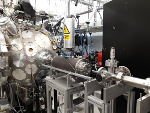| | 1 | = SmartPhantom meeting: Wednesday 5^th^ June 2019, 16:00 = |
| | 2 | |
| | 3 | == Meeting details == |
| | 4 | |
| | 5 | Teleconference |
| | 6 | |
| | 7 | Phone details: |
| | 8 | {{{ |
| | 9 | UK: 08082 380274 |
| | 10 | Austria: 0800 006612 |
| | 11 | |
| | 12 | PIN: 5904750902 |
| | 13 | |
| | 14 | }}} |
| | 15 | |
| | 16 | Full list of telephone contacts may be found [raw-attachment:Z0-Phone-details.pdf here]. |
| | 17 | |
| | 18 | == Notes: == |
| | 19 | |
| | 20 | **Present:** JB, KL, AK, HT, LC |
| | 21 | |
| | 22 | 1. Outline of design: LC \\ |
| | 23 | Present design for gluing jig was described (see [raw-attachment:190529-SmartPhantom.pdf slides]). |
| | 24 | * Questions raised: |
| | 25 | * What resin should be used? We discussed trade-off between viscosity and fibre spacing. Need to take advice from Resin Lab. |
| | 26 | * How to will a doublet layer be wound? Concept is that former is used to wind one layer of fibres. Fibres themselves for the support for the second layer. |
| | 27 | * What is the minimum bending radius of the fibre and does the lobe |
| | 28 | match the minium bend radius for the fibre? We discussed the issue |
| | 29 | of micro-cracks, which may degrade optical performance, and the possibility |
| | 30 | of fibre breaking. We agreed that we would need to address the fibre-breaking issue |
| | 31 | to avoid a lot of wasted time and material during manufacture. |
| | 32 | * **AK** agreed to find minimum bending radius; |
| | 33 | * **LC** will consider options for stopping the unravelling during manufacture. |
| | 34 | * We discussed how to move forward and **//agreed//** to move to prototype manufacture when: |
| | 35 | * LC had a chance to think about a means of mitigating issues arising from fibre breaks; |
| | 36 | * Input had been received from the Resin Lab about the various gluing issues; |
| | 37 | * Samples of printed circuit board (**JB** to supply spec) and carbon-fibre sheet have been sourced; |
| | 38 | * Further we **agreed**: |
| | 39 | * To place an order for clear fibre (**KKL, AK**) |
| | 40 | * To consider optical readout next time. |
| | 41 | 1. Slide from HT:\\ |
| | 42 | HT presented outline results of his simulation (see [raw-attachment:p207_simulation_stack_nomylar_V.png slide]). Initial conclusions: |
| | 43 | * Mylar OK if thickness is less than 300 microns per sheet |
| | 44 | * We also agreed to consider aluminium or black (anodised) aluminium |
| | 45 | * The use of (e.g.) 50 micron aluminium will be checked in simulation (**HT**). |
| | 46 | 3. **Agreed** to meet next week: |
| | 47 | * 11:00 Tuesday 11Jun19 |
| | 48 | |
